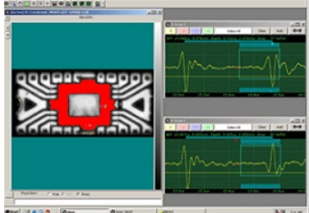




























Non destructive testing is crucial for controlling the quality of raw materials, semi-finished products, and finished products. It can monitor the metallurgical and production process quality of product materials in real time, and provide feedback information to help improve processes.
Meixin Testing provides professional non-destructive testing services, using advanced technology to ensure product quality and safety, and reduce production costs.

| Project Overview
Nondestructive testing (NDT) refers to providing real-time process quality control for raw materials, semi-finished products, finished products, and product components in either non-continuous manufacturing (such as multi-step production) or continuous manufacturing (such as automated production lines). It is especially critical for monitoring the metallurgical quality and process quality of product materials—for example, detecting defects, assessing microstructural conditions, and monitoring coating/plating thickness. At the same time, the quality data obtained through NDT can be fed back to the design and process departments, promoting further improvements in design and manufacturing processes, thereby enhancing product quality, reducing scrap and rework, lowering manufacturing costs, and improving production efficiency.
| Project Overview
Without damaging the tested object, these measurements help enterprises gain a more comprehensive, direct, and in-depth understanding and evaluation of the properties, conditions, quality, or internal structure of the inspected materials and equipment components. This contributes to monitoring product quality and improving manufacturing processes.
| Test Objective
1. Ensuring product quality
2. Safeguarding operational safety
3. Improving manufacturing processes and reducing production costs
| Service Products / Fields
PCB & PCBA, FPC, electronic and electrical products, electronic components, plastic materials, automotive materials and parts, medical devices, academic/research products, military and defense applications, and more.
| Test Item
CT scanning test
X-ray inspection test
C-SAM scanning test
Magnetic particle inspection (MPI) test
Liquid penetrant inspection (LPI) test
Eddy current testing
| Test Details
1. CT Scanning
Industrial CT has been developed on the basis of radiographic testing. Its fundamental principle is that when a collimated radiation beam with initial energy I₀ passes through the test object, the attenuation coefficients of the volumetric elements along different transmission directions vary, resulting in different transmitted energies (I) received by the detector. According to specific image reconstruction algorithms, cross-sectional tomographic images of the test object can be obtained without shadow overlap. Repeating this process yields additional tomographic images, and once a sufficient number of two-dimensional slices are collected, a complete three-dimensional image can be reconstructed. Without causing any damage to the test object, it can clearly, accurately, and intuitively display the internal structure, composition, material characteristics, and defects of the inspected object in the form of two-dimensional tomographic or three-dimensional stereoscopic images. It is regarded as one of the most advanced nondestructive testing and nondestructive evaluation technologies available today.
Under the premise of not damaging the component, it enables the reconstruction of a complete three-dimensional model of the part from the inside out; supports material defect analysis, failure mode analysis, measurement of geometry and dimensional tolerances, and verification of assembly correctness.
Scope of application: electronic components, high-precision components, PCB/PCBA, and related assemblies.
Industrial CT testing applications: defect analysis, dimensional measurement, CAD model comparison.
2. X-ray inspection
For areas of a sample that cannot be examined visually, X-ray imaging is employed by recording the change in light intensity as X-rays penetrate materials of different densities. The resulting contrast forms an image that reveals the internal structure of the specimen, thereby enabling the observation of problematic regions inside the test object without causing any damage.
Scope of application: detection of cracks and foreign object defects inside metal materials and components, plastic materials and components, electronic devices, electronic assemblies, and LED elements; analysis of internal displacements in BGAs and printed circuit boards; identification of soldering defects such as voids and cold joints in BGA assemblies; analysis of internal conditions in microelectronic systems, encapsulated components, cables, fixtures, and plastic parts.
3. Ultrasonic Scanning (C-SAM)
Ultrasonic scanning detects defects by analyzing how acoustic properties associated with material flaws affect the propagation of ultrasonic waves within the inspected material. It is commonly used for the inspection of both internal and surface defects.
Scope of application: plastic-encapsulated ICs, wafers, PCBs, LEDs, and similar components.
X-ray inspection: a nondestructive testing method that uses X-rays or other radiation to detect internal defects in metals.
Magnetic particle inspection: a nondestructive testing method that identifies surface and near-surface discontinuities in test pieces by utilizing magnetic flux leakage in combination with suitable inspection media.
Penetrant inspection: a method in which a penetrant is applied to the part, excess penetrant is removed using a cleaning agent, and then a developer is applied to reveal surface-breaking defects on the component.
Eddy current inspection: a nondestructive testing method that evaluates the quality condition of a test piece by analyzing eddy currents induced within the material.
Ultrasonic inspection and radiographic inspection are the most widely used techniques for internal defect detection. For surface defect detection, magnetic particle inspection is primarily applied, and it is the preferred method for all ferromagnetic materials.
In industry, ultrasonic inspection is predominantly used for metals but can also be applied to other materials; radiographic inspection has a wide application range, mainly for metals; magnetic particle inspection is limited to ferromagnetic materials; penetrant inspection can be applied to both metallic and nonmetallic materials; eddy current inspection is applicable only to conductive materials.
| Testing Item
|
测试项目 Test Item |
汽车零部件缺陷检测 Automotive Component Defect Detection |
|
零部件尺寸测量 Dimensional Measurement of Components |
|
|
零部件孔隙率检测 Porosity Inspection of Components |
|
|
零部件数模比对 CAD-to-Part Comparison for Components |

